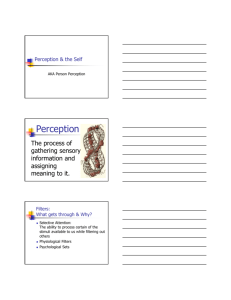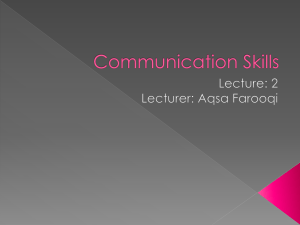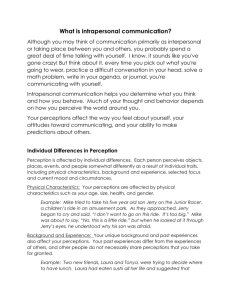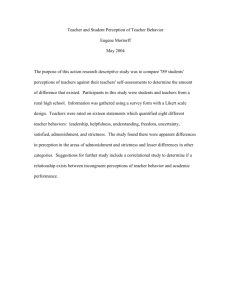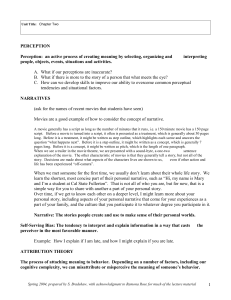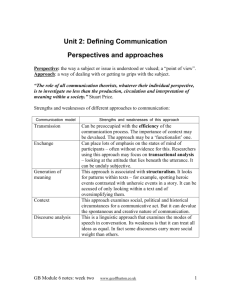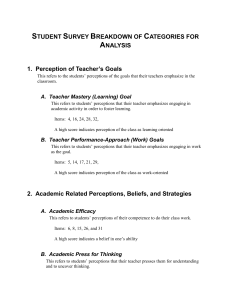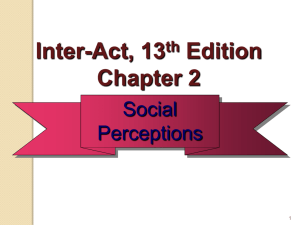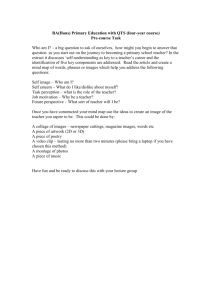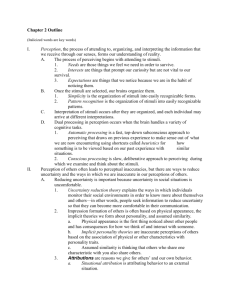Lesson 5 - Geoff Barton
advertisement
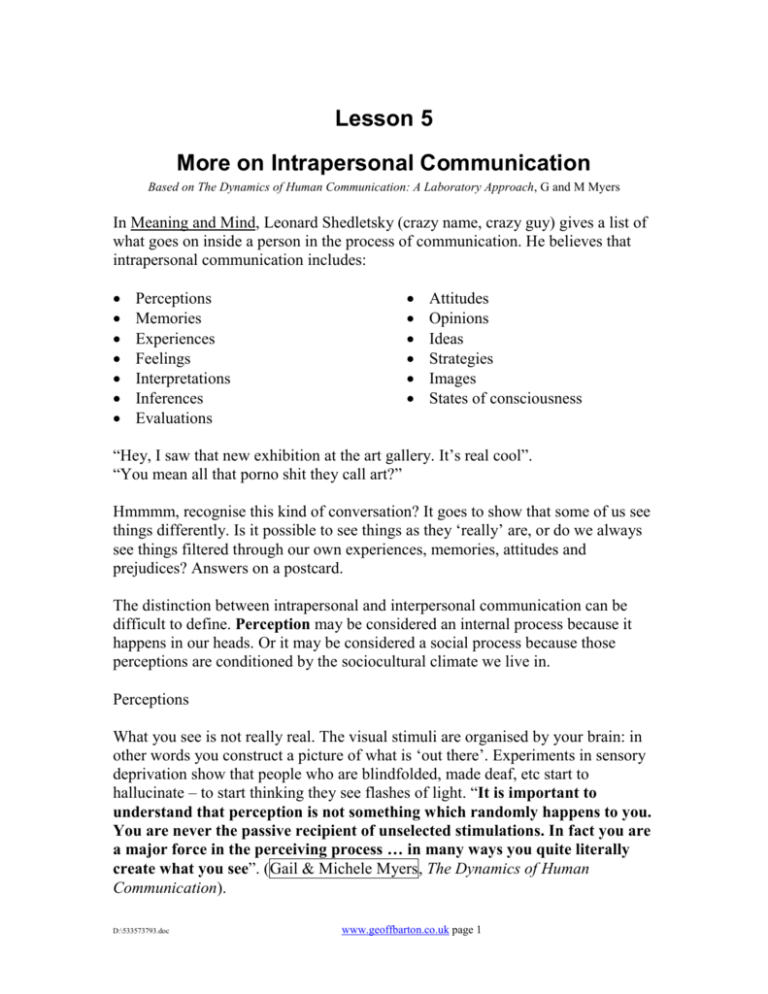
Lesson 5 More on Intrapersonal Communication Based on The Dynamics of Human Communication: A Laboratory Approach, G and M Myers In Meaning and Mind, Leonard Shedletsky (crazy name, crazy guy) gives a list of what goes on inside a person in the process of communication. He believes that intrapersonal communication includes: Perceptions Memories Experiences Feelings Interpretations Inferences Evaluations Attitudes Opinions Ideas Strategies Images States of consciousness “Hey, I saw that new exhibition at the art gallery. It’s real cool”. “You mean all that porno shit they call art?” Hmmmm, recognise this kind of conversation? It goes to show that some of us see things differently. Is it possible to see things as they ‘really’ are, or do we always see things filtered through our own experiences, memories, attitudes and prejudices? Answers on a postcard. The distinction between intrapersonal and interpersonal communication can be difficult to define. Perception may be considered an internal process because it happens in our heads. Or it may be considered a social process because those perceptions are conditioned by the sociocultural climate we live in. Perceptions What you see is not really real. The visual stimuli are organised by your brain: in other words you construct a picture of what is ‘out there’. Experiments in sensory deprivation show that people who are blindfolded, made deaf, etc start to hallucinate – to start thinking they see flashes of light. “It is important to understand that perception is not something which randomly happens to you. You are never the passive recipient of unselected stimulations. In fact you are a major force in the perceiving process … in many ways you quite literally create what you see”. (Gail & Michele Myers, The Dynamics of Human Communication). D:\533573793.doc www.geoffbarton.co.uk page 1 “Communication is essentially a process of making up your own reality through perception and symbolisation. How you do this also influences the information you will select … Thus you begin a cycle of paying attention to things which interest you and then making up your own behaviours and comments based on those selections”. (ibid) Perceptions are therefore not neutral. Your expectations of people and things will often define how you react to them. You will also be affected by: physiological factors – how you are built – eg how good your eyesight is, how subtle your sense of taste, etc. psychological factors – eg: motivation (if you are hungry you will detect food smells more than if you were not) perceptual set (past experience and past learning): people talking behind you: if you suddenly hear your name you will tune in to them; similarly, habit changes the way we notice things, as does expertise (a jeweller will see a ring differently from a bodybuilder). Heisenberg’s “uncertainty principle” has shown us that it is impossible to see the world as it is: by watching it, you change and distort it. Our perceptions ORGANISE and INTERPRET. Mr B has produced some funky perception tricks to amaze and startle you. All of this suggests that, oh dear, intrapersonal communication may be valid after all – because even this most private form of communication involves organisation, interpretation and symbolism. Ho hum. D:\533573793.doc www.geoffbarton.co.uk page 2 Who are you?* *and, while you’re at it, who am I? The main way you filter your perception of the world is through your perception of yourself. You also use other people to find out about yourself. Past experience affects your present behaviour – eg remembering what went on yesterday will shape how you behave today. Psychologists teach us that the main assumptions about self-concept is learned, maintained and changed through interpersonal communication. How you see yourself is a result of how you see others seeing you. This is sometimes referred to as a “looking-glass self”. When you were born you did not have a sense of self. The way you were treated laid foundations upon which you developed thoughts and feelings about who you are. Language introduced permanence into the objects around you. How people spoke to you will have made a great impression – including gender assumptions (“boys don’t cry”). From 10 months to 18 months you imitated without understanding the action and language of people around you. Later, you began role-playing. From 3-5 this role play shows the child imagining her/himself into the mind of another person. Finally you reach a stage where you no longer need to play the role of another person to see how that person may respond to you – you do it in your head = “symbolic role-playing” (Berlo) – eg “what would Daddy say about that?”. Next you begin to think in terms of other people (not just immediate family) – “generalised others” – and how they perceive you. This will be driven by your self-concept. If you are a poor conversationalist, you will expect others to see you in that way. This will not remain static: your self-concept develops. It will be affected also by the self-fulfilling prophesy or “Pygmalion effect” – if you are told you are clever, you are more likely to perform at a high level. You will seek constant validation of your self-image. Your behaviour and language will aim at confirmation and disconfimation. Unless you get clear and supportive messages, you are not likely to have effective communication experiences. So … self-perception is a major filtering system. It affects the way we see the world. D:\533573793.doc www.geoffbarton.co.uk page 3 Confirmation of your self-image leads to self-esteem (ie your image of yourself is confirmed by others). Some features of low self-esteem: Some features of high self-esteem Cliché phrases (like, you know, people are like that) Much talk of criticism (I’m all thumbs) Inability to accept praise gracefully Defensiveness about blame Cynicism about accomplishments Whining and sneering tone Pessimistic attitude about competition Use of original expressions Talk about the self less Accept praise Give credit to others Confident tone Admission of a wide range of feelings Optimistic attitude to competition Lack of dogmatism about beliefs You have some control over your self-image, with three overlapping ranges: 1 physical age, height, weight, hair colour if you consider yourself a physical weakling, you will not attempt the role of bully or athlete. 2 role you play a range of roles – eg son, brother, student, patient You will spend time checking to see whether you are playing roles properly in specific situations 3 introspective these are your deep feelings, faith, beliefs – many of which you may not want to share with others. Your behaviour towards others seems to be directly linked to how you see yourself. How others take your actions and then respond to you gives you both data about yourself and some choices for how to proceed. Look into my eyes. You are feeling sleepy GB March 3, 2016 … D:\533573793.doc www.geoffbarton.co.uk page 4

